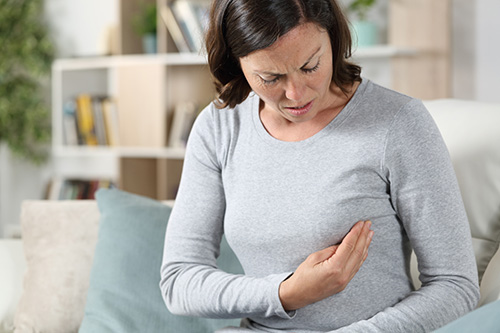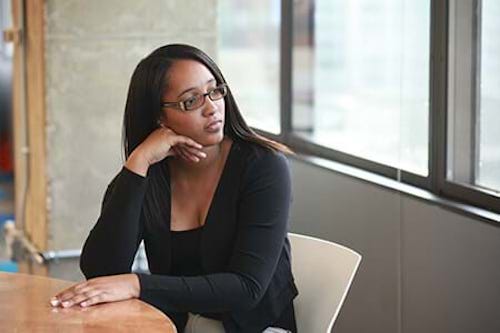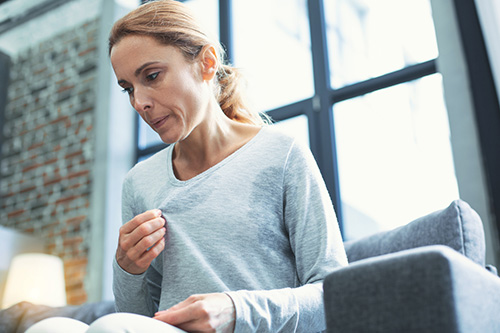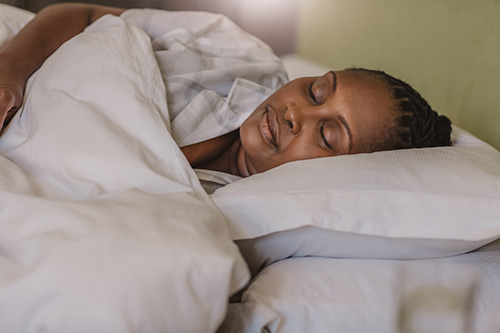If you experience pain in one or both breasts, your immediate reaction may be to wonder — do I have breast cancer? It may be reassuring to know that in general, out of thousands of women with breast pain, only a few will prove to have breast cancer. But that breast pain is real — women are not making it up — and it does cause a lot of sleepless nights even if you’re not thinking about cancer.

The causes of breast pain, or mastalgia, are complicated, so there is no quick and easy solution. We advise women with breast pain to consider a combination of conventional and alternative therapies for breast pain that have been shown to offer relief.
Symptoms and causes of mastalgia
Many women experience breast pain in conjunction with their menstrual cycle. They have swelling, sensitivity, achiness, and in severe cases, throbbing and sharp pain in both breasts. It may occur for only 2 or 3 days a month just before your period, or it could last as long as a week — or longer! This sort of breast pain is related to shifting hormones; it is often an indication of excess estrogen, which is why it occurs in the part of your cycle where estrogen is high and progesterone is low. (If this sounds like you, keep track of the pain on a calendar for a couple of months and see if you can find a pattern.)
Sometimes, you might have localized pain only in one breast. It might be intermittent, changing with your cycle, or it might hurt all the time. The most likely explanation for localized pain is an inflamed (but benign) cyst. Fibrocystic breast tissue is nothing to worry about, but you’ll want to keep track of the lumps and bumps so you can identify any new ones and get them checked out. While we’re taught to think that a lump (painful or otherwise) is a sign of cancer, more often than not it isn’t—but it’s still best to see your practitioner if you find a new one.
When you’ve put up with breast pain for years, you might look forward to menopause, thinking that will solve the problem. The good news is, you might be right: the majority of breast pain goes away after menopause! Unfortunately, as an indicator of hormonal imbalance, for some women it may continue for a while after menopause. A small number of women have sensitive breasts in their 70s.
Fortunately, we have a plan for dealing with breast pain at any age.
Moving past mastalgia: Start with a breast review
The first step when you’re experiencing mastalgia is to talk to your primary care provider about it. If you are over 35, have you had a mammogram in the last 6 months? If not, it may be prudent to get one, but try to schedule it when your breasts are least tender. If you have recently had a mammogram or are under 35, you should ask to get an ultrasound. Ultrasounds may reveal cysts which often cannot be felt but expand (usually as your hormones fluctuate) and stretch nerve fibers, causing pain. Often just knowing that you have benign lumps, or that the ultrasound showed normal tissue, is very reassuring.
There are also some prescription medications that can cause breast pain. Birth control pills, some types of antidepressants, and some medications for hypertension are among these. If you are taking such medications, ask your primary care provider if there’s an alternative option that won’t cause as much pain.
Look at what you are eating
Breast care doctors haven’t found one food that causes breast pain for everyone, nor one thing that cures it for everyone. However, caffeine does affect many women by dilating vessels and stretching nerves, and many women find relief after cutting back on coffee. Salt works the same way for some women, too. Increasing fiber and eating more dark green leafy vegetables can help by flushing out excess estrogen (aside from being good for you in general). Some women find relief by taking a short fast or detoxification.
Consider phytotherapy and nutrients
Herbal phytotherapy, including our Herbal Equilibrium formula, can be used to restore hormonal balance between estrogen and progesterone levels, diminishing hormone-related breast pain. If you are experiencing multiple symptoms of hormonal balance, our Breast Health Combo with Vitamin D and DIM helps to provide the broader support you need.
“Over time, I had simply come to accept that for two weeks out of every month I would have to put up with the break-outs, the bloating, swollen and sore breasts, depression, and other symptoms. I’m going through my third cycle now since starting the Hormonal Health Protocol I can’t begin to tell you how good I’m feeling. Virtually symptom-free.”
— Brooke, Women’s Health Network customer and woman who experienced breast pain
Other natural remedies for breast pain relief include evening primrose oil (EPO), although studies show it can take a while to start working. For added nutritional support, women can benefit from taking a high-quality multivitamin/mineral with an omega-3 supplement. Some small studies suggest that EPO and omega-3s (fish oil) together is also beneficial for reducing breast pain.
Relieve pressure points
If there is one “trigger” point where pain is consistent, try massaging the area yourself or finding a lymphatic massage specialist. Often the area is in the upper outer part of the breast where an underwire point hits. Wearing non-underwire bras or sports bras might help reduce the pressure on the painful spot, but it’s important to make sure they fit properly. One of the most consistent recommendations for relieving breast pain is to ensure you wear a supportive, well-fitting bra — so do take the time to go to a specialty store and get correctly sized!
Manage your stress
One expert told us that she feels as if her breasts are just screaming out, “Take care of me!” Breast pain is stressful — and stress can cause heightened inflammation, which may lead to more pain. Try to take a break and do something you want to do, just for yourself. Intentionally breaking the stress–pain feedback loop may be all it takes.
We hope we will understand one day the mystery of hormones, and how everyone is the same yet very different. In the meantime, remember that what you are experiencing is probably normal, just very individual.










